Last Updated on March 28, 2025 by Owen McGab Enaohwo

Many organizations need to pay more attention to the importance of work instructions, assuming that their processes are self-explanatory or that existing training programs are sufficient. Not surprisingly, this doesn’t end well, as failing to create detailed work instructions can have serious consequences.
Effective communication is the backbone of any successful organization, offering numerous benefits that can impact productivity, efficiency, and overall performance. Having well-crafted work instructions helps to achieve these. In this article, we’ll share 11 free work instruction templates and provide a step-by-step guide on how to write one to get you started.
What You’ll Learn In This Guide:
What Is the Purpose of a Work Instruction Template?
11 Free Work Instruction Templates for Different Environments
How to Write Work Instructions for Your Business (A Step-by-Step Guide)
How to Create and Manage Your Work Instructions Using SweetProcess
What to Include in a Standard Work Instruction
What Makes a Great Work Instructions Template?
Work Instructions vs. Standard Operating Procedures: How Do They Differ?
Create Actionable Work Instructions and Manage Them Effectively Using SweetProcess
What Are Work Instructions?
Work instructions are detailed, step-by-step documents that outline the steps needed to complete a specific job or process. They provide clear and concise instructions to ensure tasks are performed consistently, efficiently, and safely.
A typical work instruction includes a brief overview of the task or process. It also contains detailed, sequential instructions for completing the task and identifies who is responsible for achieving it.
Work instructions are commonly used in various industries and organizations to ensure consistency by standardizing processes and tasks. They help minimize mistakes and errors and streamline processes and tasks to increase productivity and efficiency. In addition, work instructions provide new employees with detailed instructions and guidelines for completing tasks and processes.
What Is the Purpose of a Work Instruction Template?
A well-designed work instruction template serves several purposes, including:
Train new employees about the company’s processes and procedures
A work instruction template provides a clear and concise guide for new employees to learn about the company’s processes and procedures. This helps to reduce the learning curve, ensuring that new employees can quickly become productive and efficient. With a work instruction template, new employees can easily understand their roles and responsibilities and start contributing to the organization sooner.
Reduces the Risk of Human Errors When Employees Are Working on a Specific Task
Work instruction templates can minimize the risk of human errors by providing step-by-step instructions for specific tasks. It ensures that tasks are completed correctly, reducing the likelihood of mistakes and errors. By following a standardized process, employees can avoid common pitfalls and ensure that tasks are completed accurately and efficiently.
Enhances Effective Communication in the Company

A work instruction template ensures all employees are on the same page and understand their roles and responsibilities. This will promote effective communication and reduce misunderstandings and miscommunications.
Ensures That Everyone in the Company Abides by the Regulatory Standards
Work instruction templates guarantee that everyone in the company adheres to regulatory standards and guidelines. This helps to ensure compliance with relevant laws, regulations, and industry standards. By following standardized procedures, companies can avoid costly fines and penalties associated with non-compliance.
Outlines How Employees Can Perform Complex Tasks in a Simple Step-by-Step Instruction
A work instruction template breaks down complex processes into simple, easy-to-follow instructions. It will help to simplify complex tasks, making it easier for employees to understand and complete them. This ensures that employees can complete tasks efficiently and effectively without feeling overwhelmed.
Helps the Company Implement a Consistent Method for all Processes
Work instruction templates establish a standardized approach to all processes and procedures. This ensures consistency across the organization, reducing variability and errors. Everyone following the same procedures eliminates confusion and ensures tasks are completed correctly.
Facilitate Continuous Improvement
A work instruction template encourages employees to suggest improvements and updates, leading to ongoing refinement and optimization of processes. This promotes a culture of continuous improvement, where employees are empowered to identify areas for improvement and implement changes.
Ensure Accountability
A work instruction template clearly outlines responsibilities and expectations, promoting a culture of accountability and ownership. When employees understand their roles and responsibilities, they are more likely to take ownership of their work and be accountable for their actions.
Enhance Employee Confidence
A work instruction template gives employees the knowledge and guidance to perform their tasks confidently. This boosts employee morale and motivation, as employees feel more capable of completing tasks.
Reduce Supervision Requirements
Work instruction templates enable employees to work independently with minimal supervision by providing clear instructions and guidelines. This reduces the need for constant oversight, allowing managers to focus on more strategic tasks and avoid micromanagement.
When you use SweetProcess, you get all of these benefits and more. Sign up here to begin your free trial.
7+ Free Work Instruction Templates for Different Environments
Work instruction templates are essential for streamlining processes, ensuring consistency, and reducing errors. Here are 11 free work instruction templates for various environments:
ISO 9001 Work Instruction Template
This template is designed for organizations that operate under the ISO 9001 quality management standard. This international standard outlines the requirements for a quality management system (QMS) and is designed to help organizations meet customer and regulatory requirements while improving efficiency and reducing waste. This template provides a structured format for documenting work instructions, ensuring compliance with the standard.
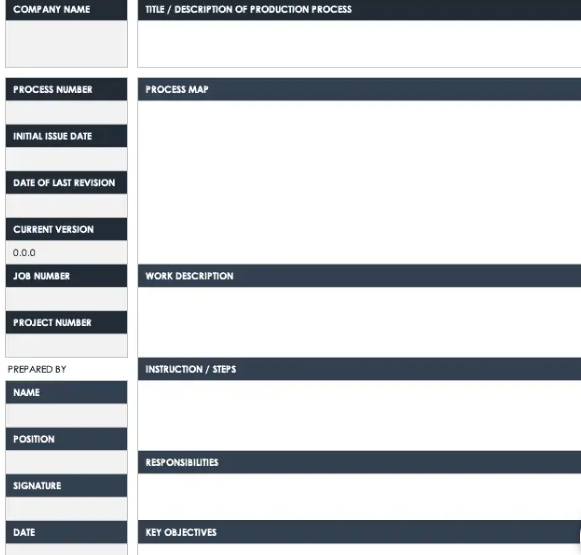
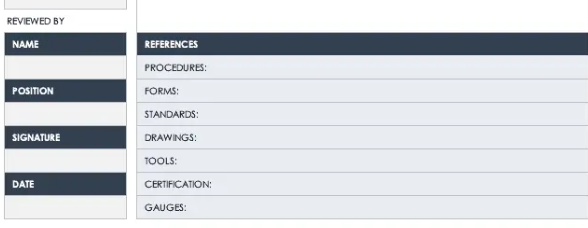
Download the ISO 9001 Work Instruction Template
Project Work Instruction Template
This template is ideal for project managers who must create work instructions for team members. It outlines the project scope, tasks, and responsibilities, ensuring everyone is on the same page.
Manufacturing Work Instruction Template
This template is designed for manufacturing environments. It provides a clear and concise format for documenting work instructions and includes sections for materials, equipment, and quality control.
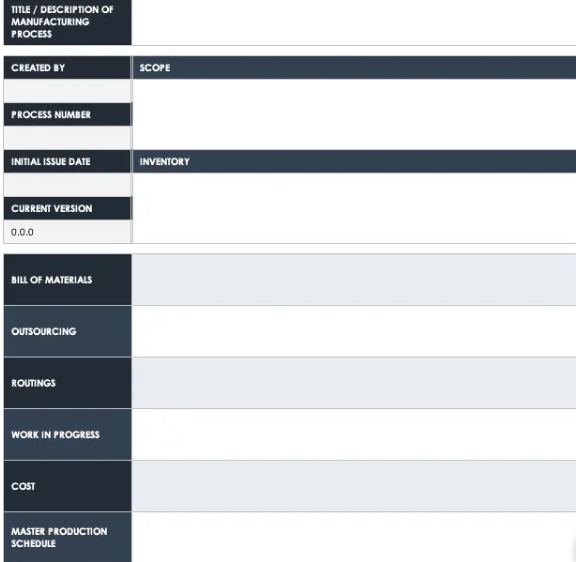
Download the Manufacturing Work Instruction Template
Assembly Work Instruction Template
This template is tailored for assembly-line processes and provides step-by-step product assembly instructions. It includes sections for component lists, assembly procedures, and quality checks.
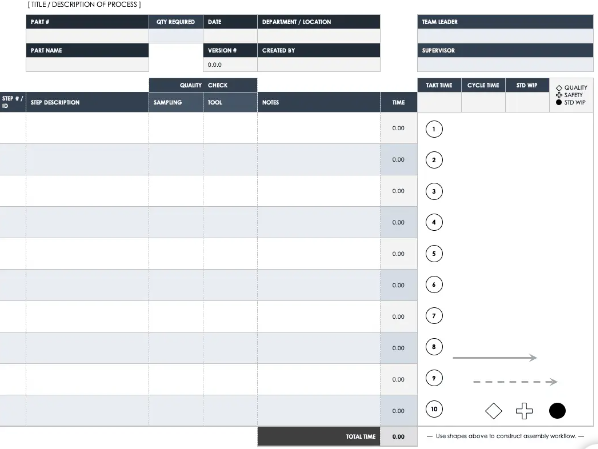
Download the Assembly Work Instruction Template
Engineering Work Instruction Template
This template is designed for engineering environments. It provides a structured format for documenting work instructions and includes sections for design specifications, materials, and testing procedures.
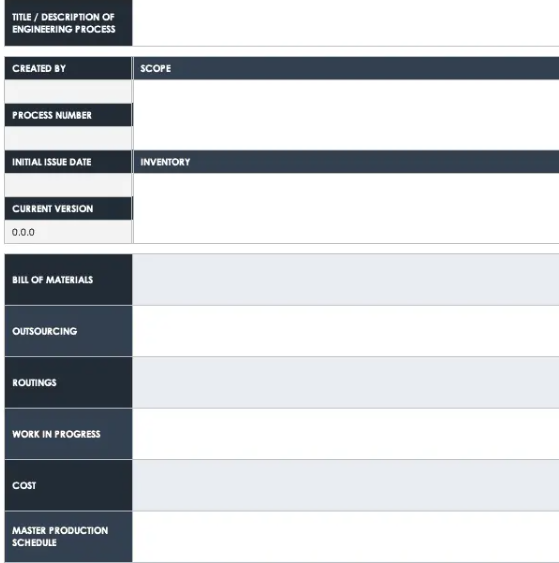
Download the Engineering Work Instruction Template
Warehouse Work Instruction Template
This template is ideal for warehouse environments. It provides clear instructions for receiving, storing, and shipping inventory. It includes sections for inventory management, safety procedures, and quality control.
Construction Work Instruction Template
This template is designed for construction environments. It provides step-by-step instructions for building and construction projects. It includes sections for materials, equipment, safety procedures, and safe work method statements.

Download the Construction Work Instruction Template
Safety Work Instruction Template
This template is essential for ensuring workplace safety. It provides clear safety procedures, emergency response plans, and hazard reporting instructions.
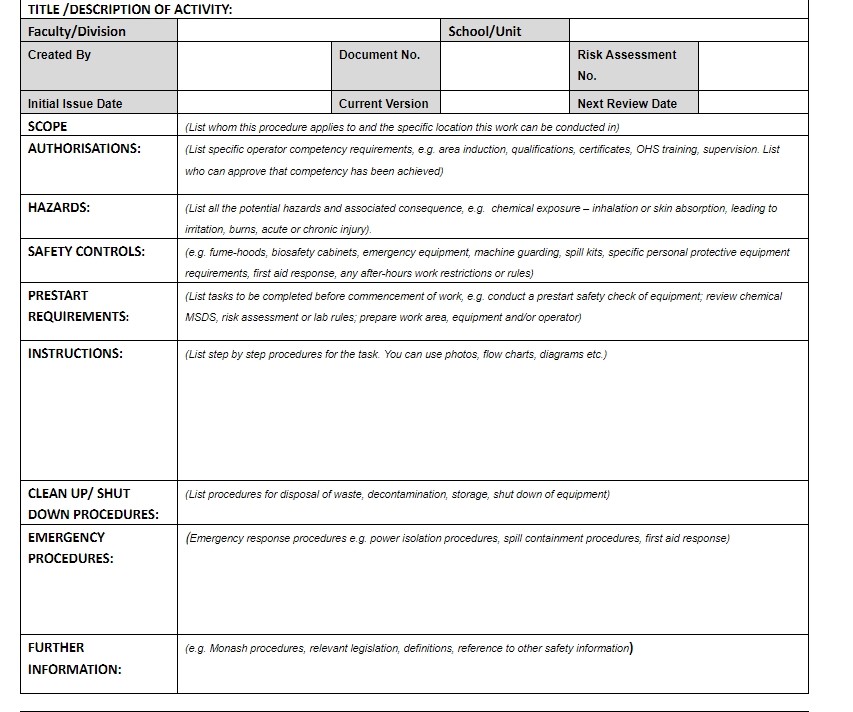
Download the Safety Work Instruction Template
Visual Work Instruction Template
This template is ideal for visual learners. It provides a graphical representation of work instructions and includes sections for diagrams, flowcharts, and images.
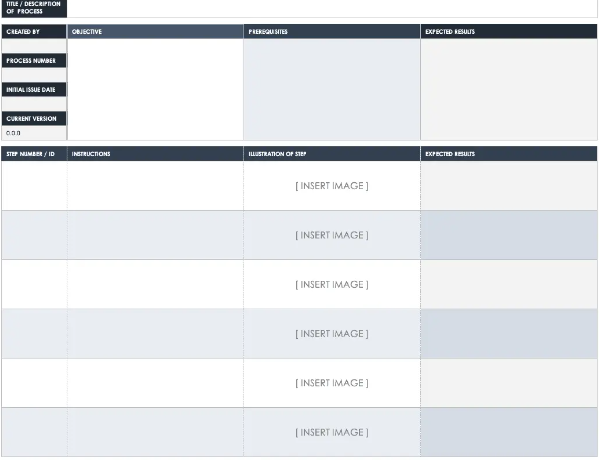
Download the Visual Work Instruction Template
Maintenance Work Instruction Template
This template is designed for maintenance environments, providing step-by-step instructions for equipment maintenance, repairs, and troubleshooting.
Laboratory Work Instruction Template
This template is tailored for laboratory environments and provides clear instructions for laboratory procedures, safety protocols, and equipment operation.
How to Write Work Instructions for Your Business (A Step-by-Step Guide)

We’ve seen the importance of work instructions and what a standard template looks like. This section will walk you through writing effective work instructions for your business’s unique needs.
Step 1: Choose a Task or Job for the Work Instructions
Identify a specific task or job that requires clear instructions. Tasks critical to your business operations have a high risk of error or injury, require specialized knowledge or skills, and are performed frequently or repeatedly should be considered.
Step 2: Write a Clear Title
Create a concise and descriptive title that clearly states the purpose of the work instructions. The title should be easy to understand and accurately reflect the content.
Most importantly, be concise and to the point.
Step 3: Write a Brief Introduction
Provide a brief overview of the task or job. The introduction should summarize the task and state its importance. Any other relevant background information can be included.
Step 4: Explain the Purpose of Work Instruction
Clearly state the purpose of the work instruction. It should answer questions like what the instruction aims to achieve, why it is necessary, and how it will benefit the employee or the organization. The purpose of your work instruction will be clearly stated when you answer these questions.
Step 5: Describe the Work Instructions (How to Do the Work)
Next, provide a detailed description of the task or job. State the steps involved in carrying out that task, the materials and equipment required, and other necessary safety procedures or precautions.
Step 6: Break the Work Instructions Into Steps
When you’re done describing each task, break up the work instructions into clear, concise steps. You’ll provide a step-by-step guide to completing the task, add relevant illustrations, diagrams, or images, and clear instructions for each step.
Step 7: Format the Work Instructions for Easy Reading
You want to ensure that your instructions for this step are clear and easy to read and understand. Use clear headings and subheadings, break up large blocks of text, and use bullet points and numbered lists. All these should make your work instructions straightforward to follow.
Step 8: Revise, Proofread, and Edit for Simplicity
You’re almost set now, but only after reviewing and revising the work instructions to ensure they are clear, concise, easy to understand, and free of errors and ambiguities.
Step 9: Test the Work Instructions
Finally, test the work instructions with a few employees to ensure they are clear and compelling. This can help you identify any areas for improvement and make any necessary revisions before implementing the instructions more widely.
How to Create and Manage Your Work Instructions Using SweetProcess
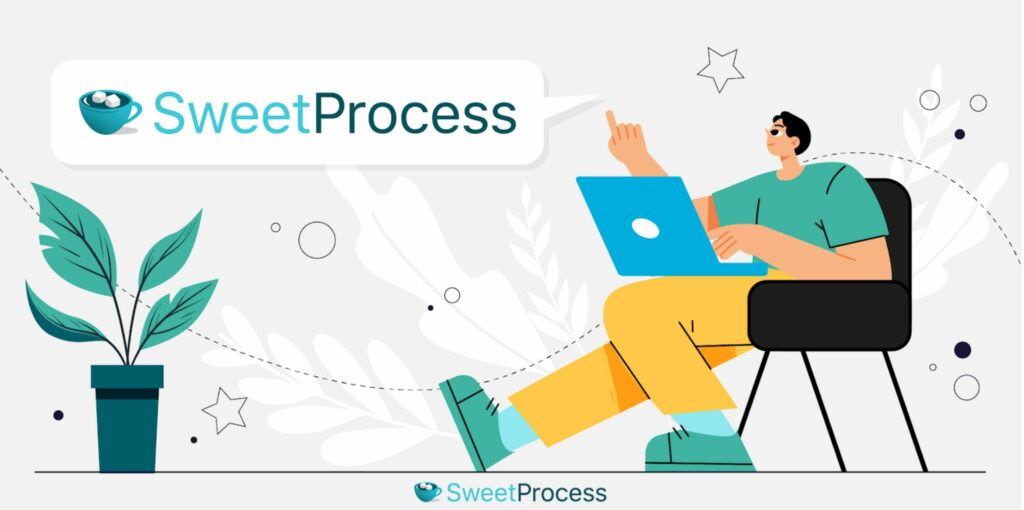
SweetProcess is work instruction software designed to help all business types have a seamless work experience. It is easy to use, so no one will be left out using this tool. This software will help you create your work instructions with the most straightforward steps, distribute them to relevant persons, and keep track of the processes currently being worked on.
Try it now for free. Let’s walk through the process of creating work instructions using SweetProcess.
Create a Work Instruction
Creating work instructions on SweetProcess is relatively easy. Simply follow these steps:
Step 1: Log in to your SweetProcess account. You’ll see a dashboard. Click on the menu and select “Procedures.”
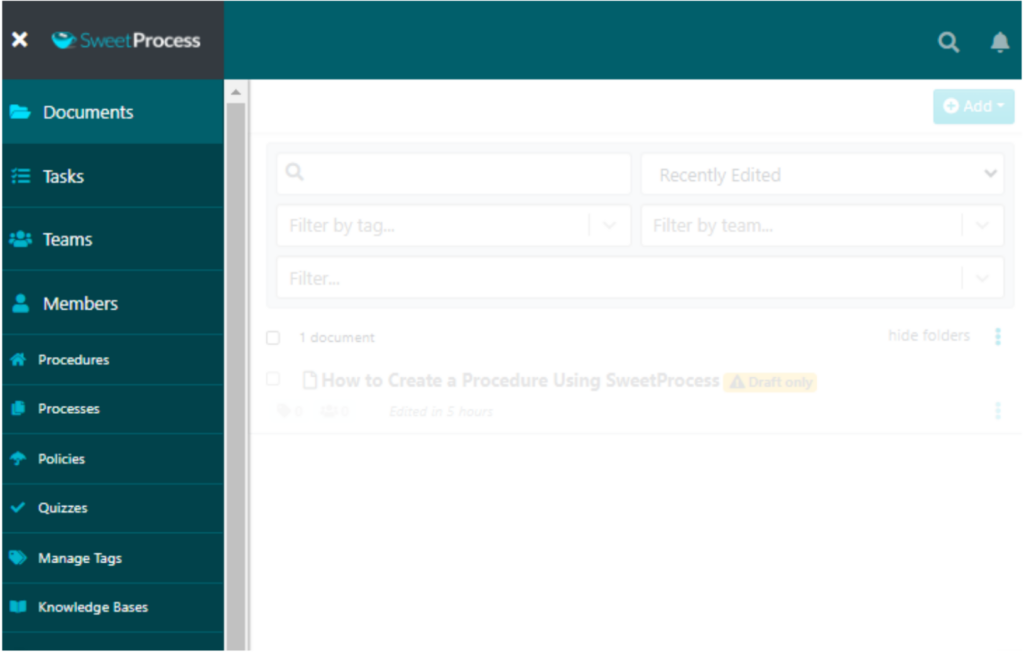
Step 2: Write the title of your procedure. Remember, provide the necessary information for whom it is being prepared.

If you choose to, you can use our built-in AI writer, SweetAI, to write the procedure or instructions based on the title’s description.
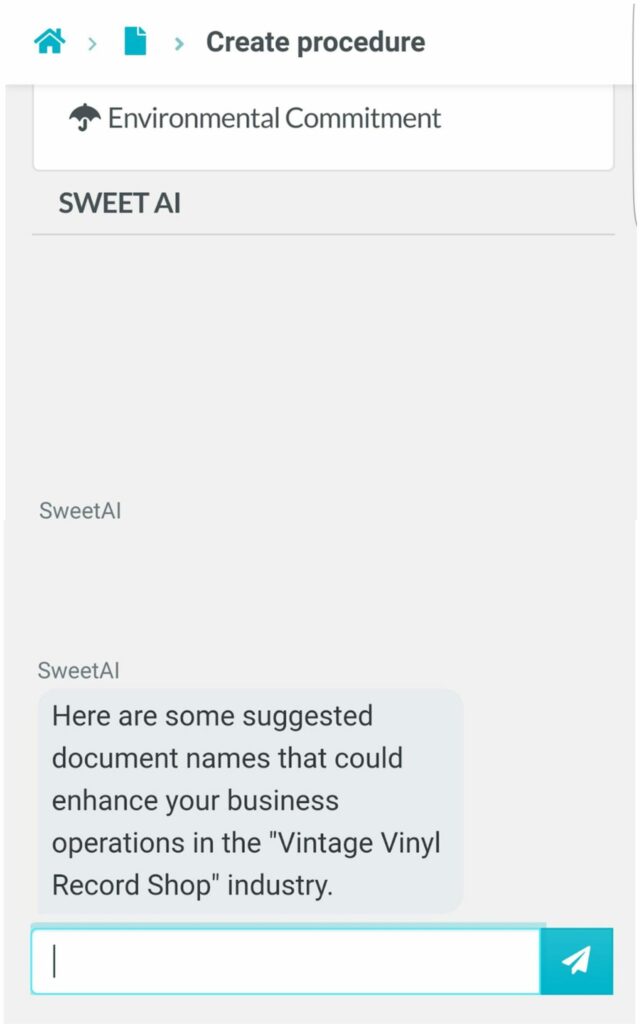
Next, click the “Continue” button.
Step 4: Proceed to add the steps to complete a procedure. You can add text, images, and videos to your steps to make them explicit. When you’re done with a step, click “Add a Step” to create as many steps as required to complete the procedure, then click “Finished Editing.”
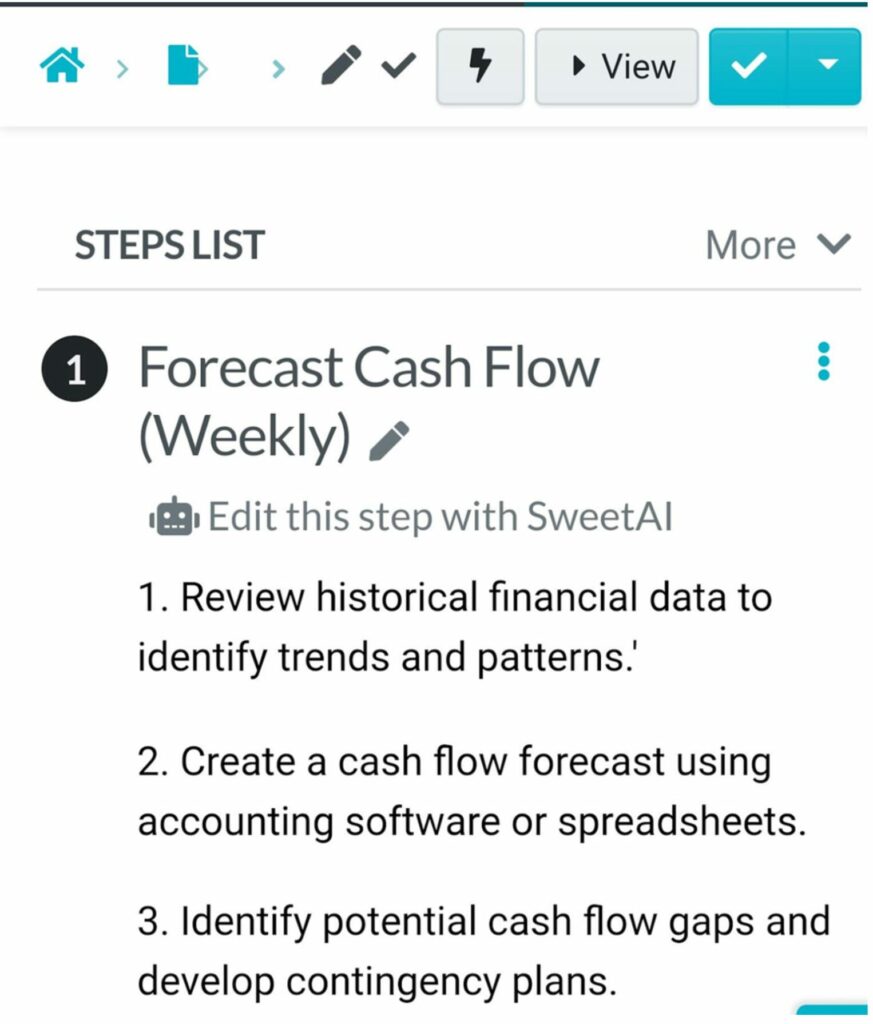
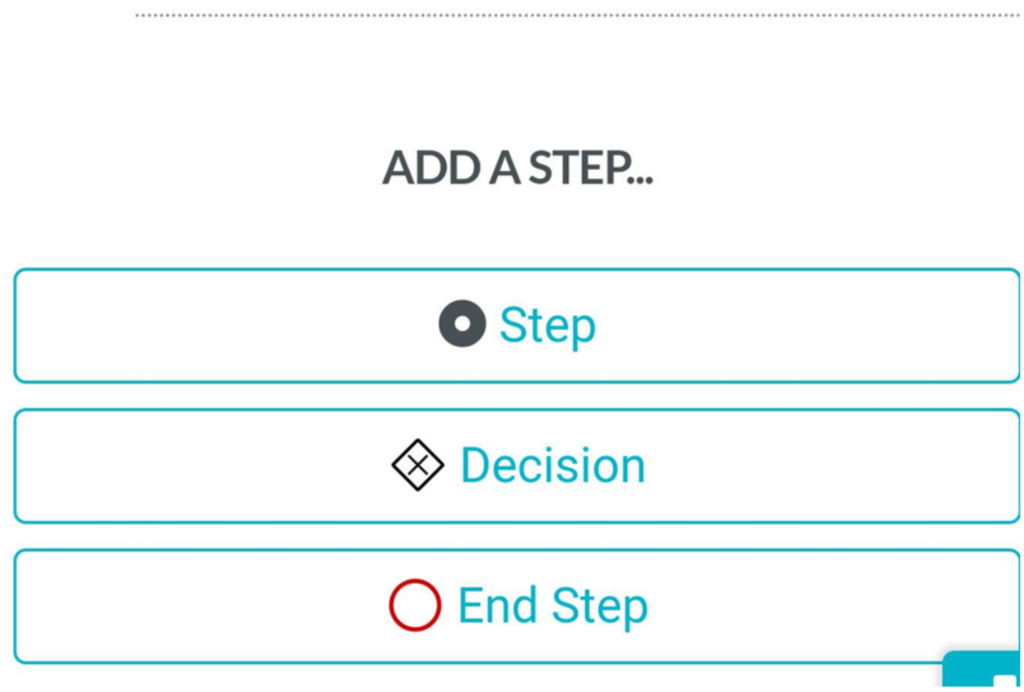
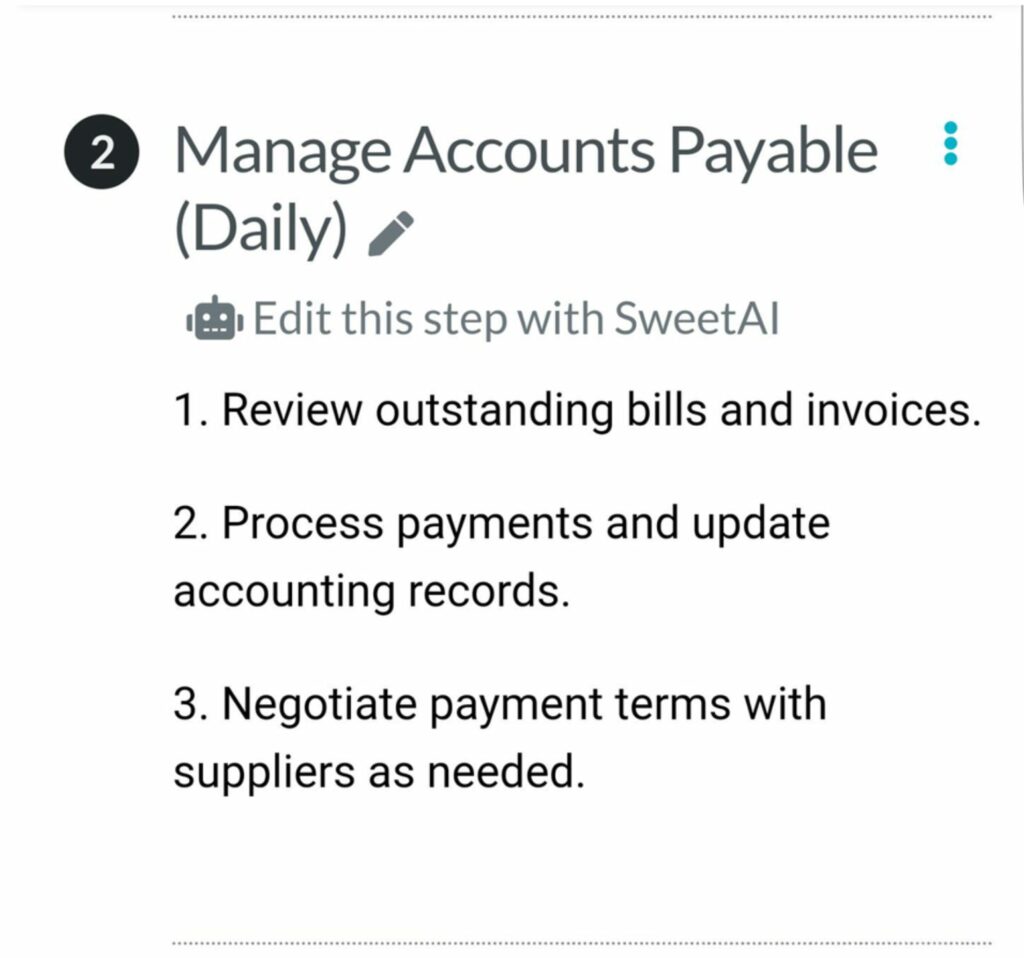
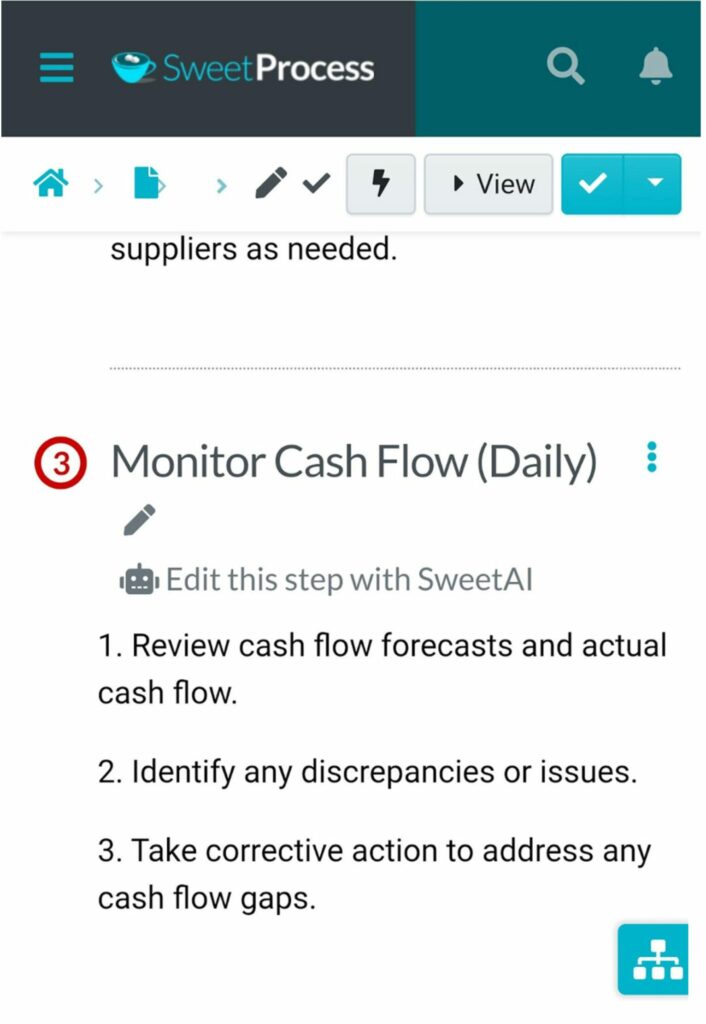
Step 5: When you’re done adding all the steps, review the entire process to ensure everything is accurate and precise. Once published, it will be accessible to your team, depending on who you have added. You can also share it via email or generate a link.
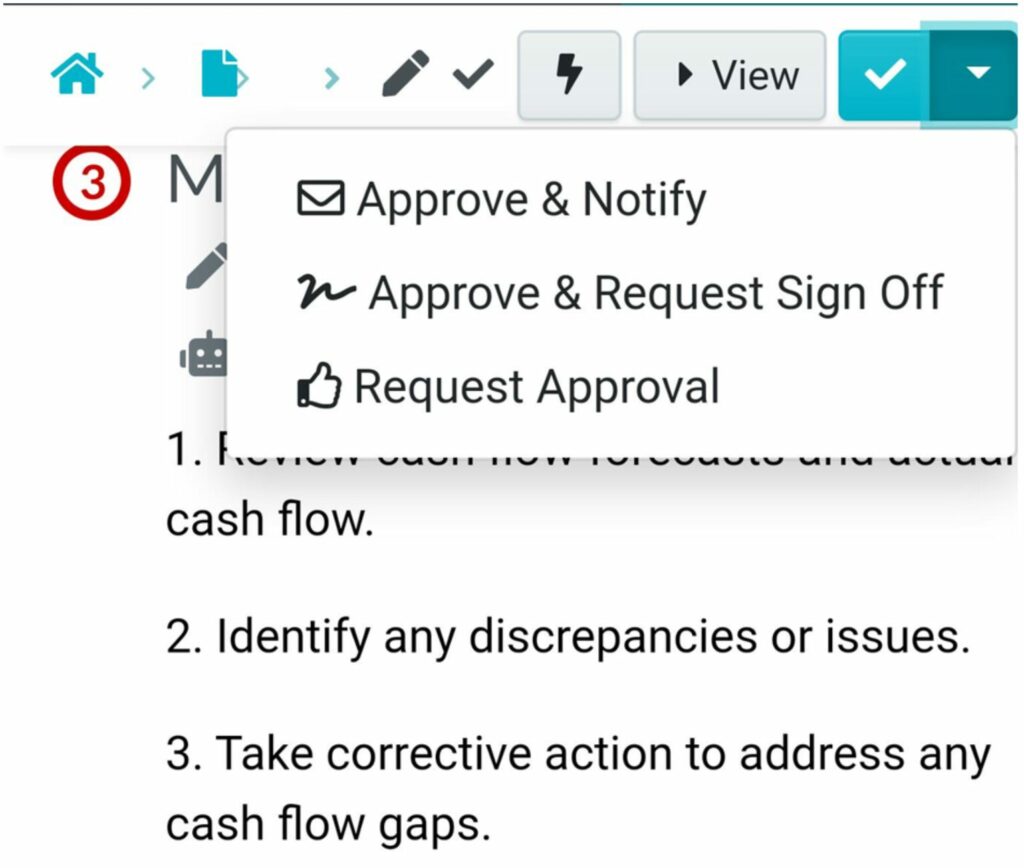
Having reliable software for your employees to make work more efficient makes you more relaxed about how work is done.
Craig Bayer, CEO of Optiable, a company that helps law firms streamline their workflows by leveraging technology, had a documentation problem and tried to resolve it by manually documenting processes and procedures.
Going through these documented processes was hard for his employees and left him with no options. He was forced to micromanage his teams. Processes and procedures were documented, but no one was looking at them, and Craig needed to know what they were doing to let employees work. Micromanaging them was a lose-lose for him and his employees. They didn’t like that, and he needed to get more of his work done.
Discovering SweetProcess made him realize the importance of systemizing operations. With the company’s processes and procedures in a place that is easy to access and use, the employees are more efficient and perform their duties practically unaided.
Manage Work Instructions
Creating work instructions on SweetProcess is only part of the process. You’ll also be able to manage your work instructions, make needed adjustments, and ensure everything is as it should be. To manage work instructions on SweetProcess, log in to your account and click on the “Documents” tab on the dashboard, where you will find all the documents created.
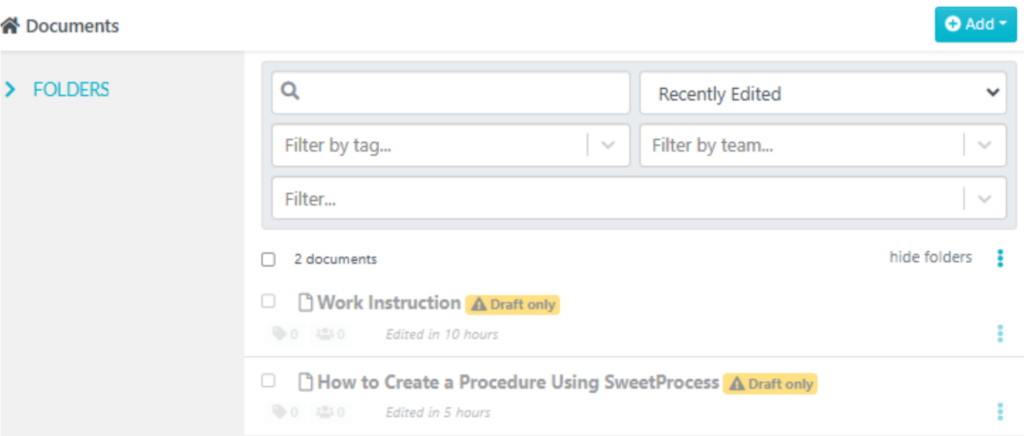
Next, find the “Work Instruction” you created and click to open it. You can then edit, duplicate, or delete the work instructions. To make changes to your document, click on the “Edit” button (typically represented by a pencil icon) to begin editing.
When you’re done making the changes, let team members know about updates. You can use the “Share” or “Notify Team” feature to send a message or email about the updated work instructions.
Having this flow in your business can change the atmosphere for good. As the head of operations at Onogo (an e-commerce business offering a wide range of consumer products), Florinela Serban was responsible for streamlining the business processes.
As the company grew, so did the demands of customers and partners. Keeping up with this rise without a solid business structure proved challenging.
A system was needed so people knew what to do to deliver the required work. SweetProcess’s effective work instructions software helped manage the changes at Onogo.
SweetProcess was able to equip its new hires for efficiency by creating process awareness.
Assign Tasks and Collaborate With Team Members
While creating your work instructions, you can assign tasks during or after you’re done. To do so, navigate to the “Task” tab on the dashboard and click the “Assign Task” button.
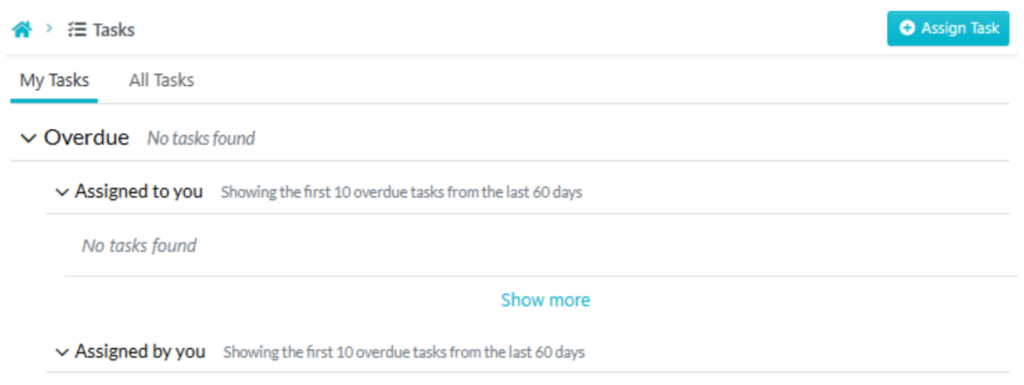
A menu with a list of existing procedures and processes will pop up. Once you select the document associated with the task to be assigned, click on the “Next” button at the bottom to choose the team member to be assigned the task. Before doing this, ensure you’ve already added the team member to the SweetProcess platform. After this, you can set the due date, and a notification will automatically be sent to the team member assigned.
Create Flowcharts From Procedures
A flow chart will automatically be created as you input your steps on SweetProcess. Follow the steps to create work instructions.
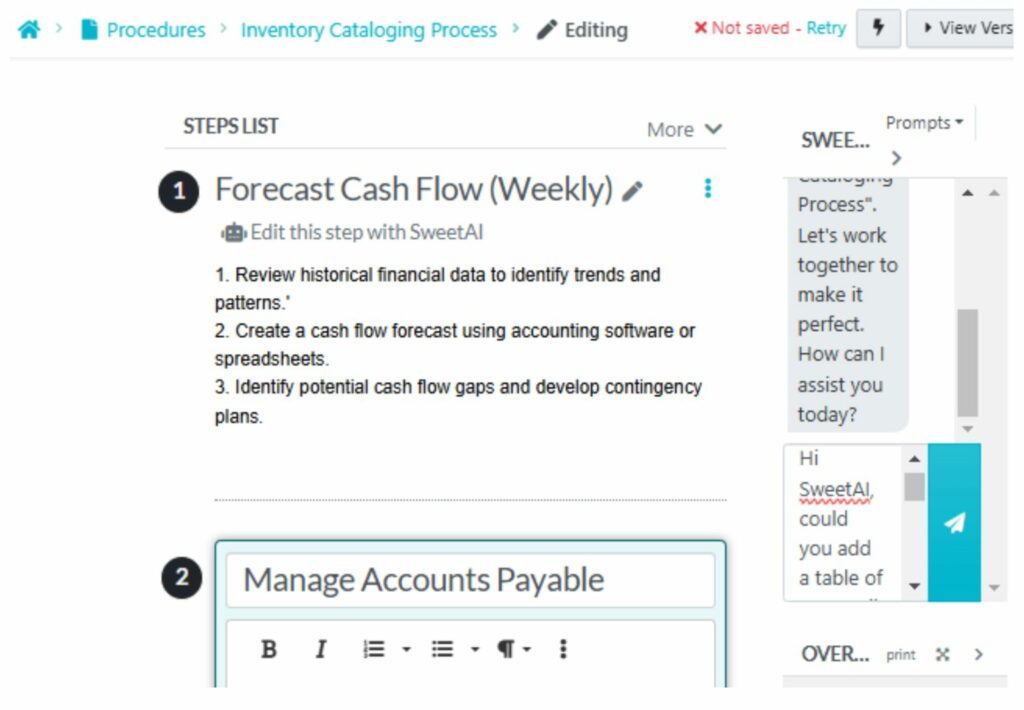
When you’re done, on the right-hand side, you’ll see a flowchart listing all the steps from beginning to end and showing what comes after the last. You can then save or print this as an extra resource.
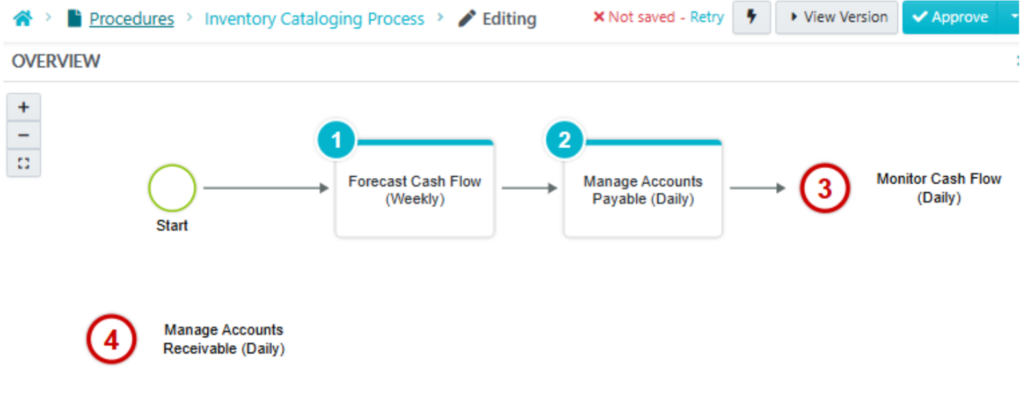
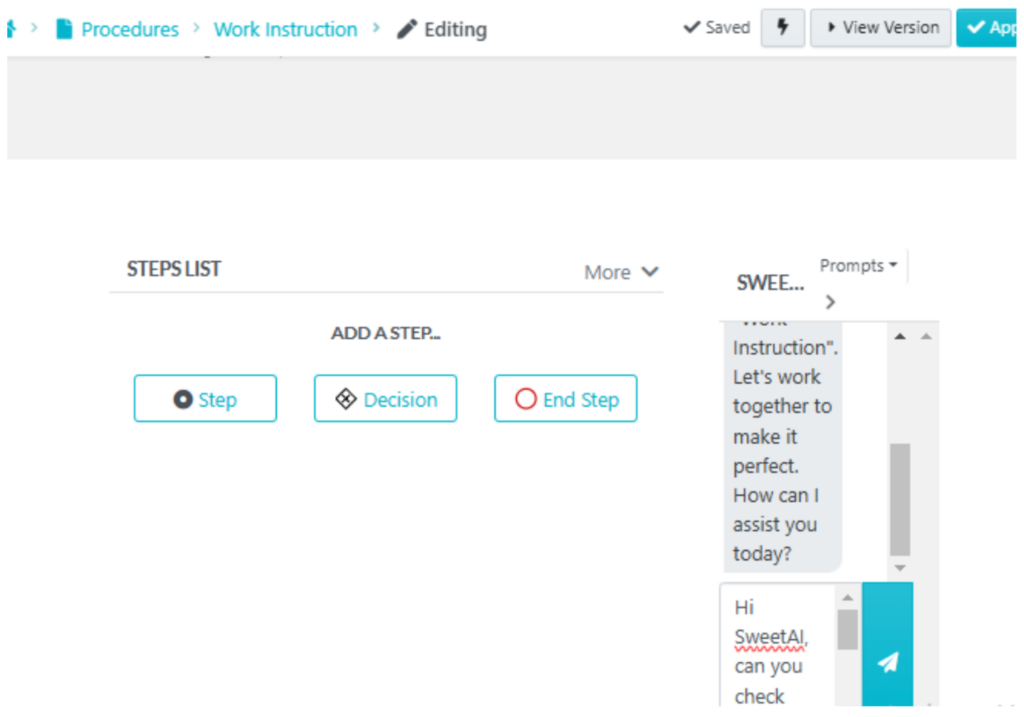
The steps are easy to follow, and the benefits of using this software are numerous. So don’t delay, sign up here!
What to Include in a Standard Work Instruction
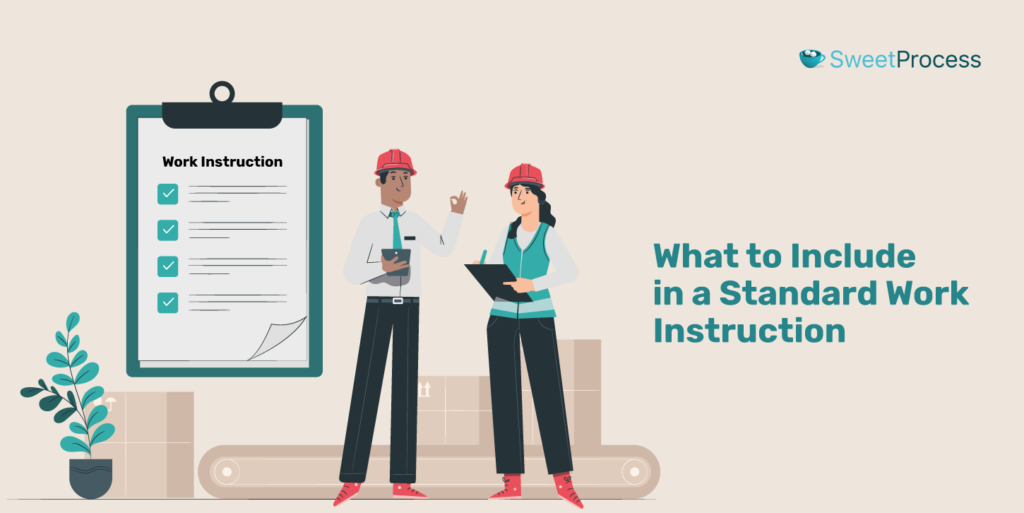
To ensure that your work instructions are practical and easy to follow, here are the essential elements to include:
Title
Write a clear and concise title that accurately reflects the task or process. The title should be descriptive yet brief, clearly indicating what the task entails. A well-crafted title will help employees quickly identify the purpose of the work instruction and understand its relevance to their role.
Short Description of the Task
Work instructions should briefly summarize the task’s purpose and scope. This section should provide a concise overview of the task, including any relevant background information or context. The short description should be free of technical jargon and complex terminology, making it easy for employees to understand.
Objectives or Expected Results
It should include a clear statement of what is expected to be achieved by completing the task. Your work instruction should outline the task’s specific goals or objectives and indicate what constitutes successful completion. The objectives or expected results should be specific, measurable, achievable, relevant, and time-bound (SMART).
Purpose of Task
It is also essential to explain why the task is necessary and how it contributes to the organization’s goals. This section should provide a clear understanding of the task’s relevance and importance and help employees understand how their work fits into the bigger picture.
Tools or Skills Required
Include a list of the tools, equipment, and skills required to complete the task. A work instruction should provide a comprehensive list of all the resources needed to complete the task, including any specialized software, hardware, or training.
Safety Requirements
Your work instructions must describe any safety precautions or protocols to be followed when completing any task. This section should outline all relevant safety procedures, including personal protective equipment, lockout/tagout procedures, and other safety measures.
Step-by-Step Instructions for the Task
Your work instructions must describe any safety precautions or protocols to be followed when completing any task. This section should outline all relevant safety procedures, including personal protective equipment, lockout/tagout procedures, and other safety measures.
Expected Outcome for Each Step
Include a clear statement of what will be achieved at each task stage. This section should concisely summarize what to expect at each step, helping employees understand what they need to accomplish and how to measure their progress.
Visual Aids
Consider including visual aids such as diagrams, flowcharts, or images to illustrate the steps involved in the task. Visual aids can clarify complex procedures, making it easier for employees to understand and follow the instructions.
Troubleshooting
Provide guidance on how to resolve common problems or errors that may occur during the task. This section should offer practical advice on how to resolve common issues, helping employees overcome obstacles and complete the task successfully.
When you create your work instructions with SweetProcess, each step you fill automatically covers the essentials of your instructions. You don’t have to worry about leaving out an element of your work instruction. So start your free trial of SweetProcess now.
What Makes a Great Work Instructions Template?

A well-designed work instruction template is essential for ensuring employees have the guidance to perform their tasks efficiently and effectively. Here are the key characteristics of a great work instructions template:
Clarity
The template should be easy to understand, with clear and concise language that avoids ambiguity. Instructions should be straightforward, and the language should be free of jargon and technical terms that might be unfamiliar to some employees.
Accessibility
The template should be easily accessible to all employees, regardless of location or role. This means that the template should be stored in a central location, such as a shared drive or an online portal, and employees should be able to access it easily.
Credibility
The template should be credible and trustworthy, reflecting the organization’s brand and values. To achieve this, relevant stakeholders should review and approve it and update it regularly to reflect changes in processes and procedures.
Consistency
The template should be consistent in layout, standard formatting, and content, making it easy to follow and understand. The language should also be consistent throughout.
Visually Appealing
The template should be well-designed and visually appealing, using clear headings, bullet points, and images to make the content easy to read, follow, and understand.
Familiarity With the Job
The template should be written by someone familiar with the job or task who profoundly understands the task and the processes involved to ensure the instructions are accurate and relevant.
Work Instructions vs. Standard Operating Procedures: How Do They Differ?
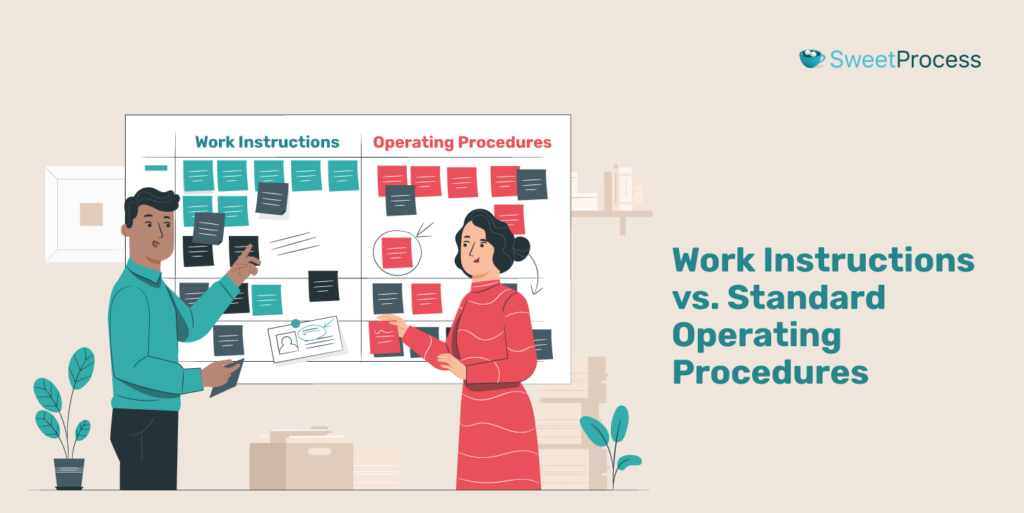
Work instructions and standard operating procedures (SOPs) are essential documents that guide employees in performing specific tasks and processes. However, they differ in scope, purpose, and content.
Work instructions provide detailed, step-by-step guidance for completing a specific task or process. They explain how to perform a task, including the necessary tools, equipment, and materials, and are often used for functions that require specific skills, knowledge, or safety protocols.
On the other hand, standard operating procedures (SOPs) provide a comprehensive guide for a specific process or system, outlining the overall workflow and responsibilities. They explain what needs to be done, why it needs to be done, and the overall objectives of the process. SOPs are often used for processes that involve multiple tasks, departments, or stakeholders.
| Work Instructions | SOPs |
| Scope: Focus on a specific task | Scope: Covers a broader process or system |
| Purpose: Provide step-by-step guidance | Purpose: Outlines the overall workflow and objectives |
| Content: Typically includes detailed, technical information | Content: Provides a more general overview of the process |
| Level of Detail: Highly detailed and specific, focusing on individual tasks | Level of Detail: Less detailed, with a focus on overall process flow and critical decision points | |
| Target Audience: Typically intended for frontline employees or operators. | Target Audience: This may be intended for a broader audience, including managers, supervisors, and support staff |
| Review and Revision: Typically reviewed and revised more frequently as tasks and processes evolve | Review and Revision: May be reviewed and revised less frequently, as overall process flow and objectives are less likely to change |
| Format: Often presented in a linear, step-by-step format | Format: May include flowcharts, diagrams, and other visual aids to illustrate process flow |
In conclusion, work instructions provide detailed guidance for specific tasks, usually complementing a standard operating procedure. While SOPs offer a broader framework for processes and systems, both SOP and work instruction documents ensure consistency, quality, and efficiency in organizational operations.
If you want software for both, SweetProcess is your app. Try it out here!
Create Actionable Work Instructions and Manage Them Effectively Using SweetProcess
With this helpful guide, you’ll be well on your way to creating clear, concise, and practical work instructions that will boost your organization’s productivity, communication, and efficiency and take your team to the next level. Work instructions will take your business to a whole new level. To achieve this even quicker, take SweetProcess along with you. Sign up for a free trial to get started!
